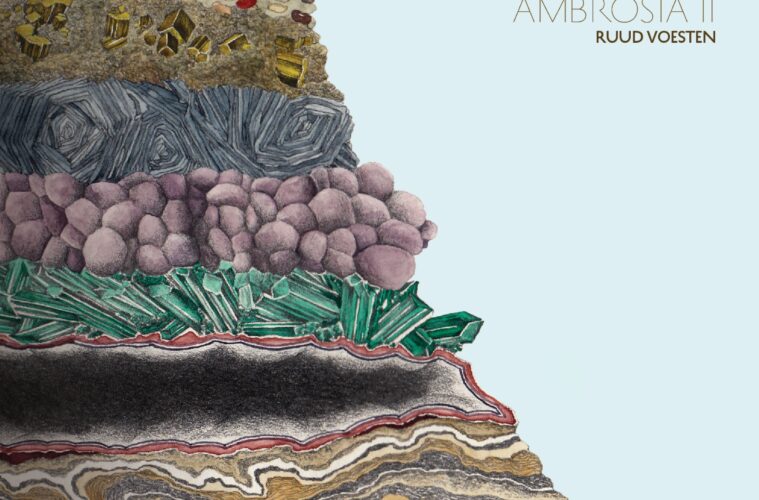Ambrosia II presents a profound and meticulously designed continuation of Ruud Voesten’s exploration into Dante Alighieri’s Divine Comedy, shifting focus from Inferno to the contemplative, transformational landscape of Purgatorio. Released on ZenneZ Records, this work extends the conceptual, emotional, and compositional structures of the 2023 debut Ambrosia, offering a multi-layered sound experience where contemporary jazz merges with ambient sensibilities and experimental electronic textures. Through this album, Voesten translates Dante’s ascent of Mount Purgatory and the encounters with penitent souls into a sonic narrative that emphasizes introspection, purification, and gradual illumination.
As a drummer, composer, and programmer, Voesten stands at the center of an intricate system that balances rhythmic sophistication with atmospheric detail. The rhythmic landscape is not based on percussive dominance alone; instead, it portrays movement, restraint, transition, and elevation. Patterns frequently evolve in cycles, suggesting both physical ascent and spiritual reformation. Rather than relying on predictable cadences, Voesten constructs rhythmic sequences that breathe, halt, recalibrate, and resume, evoking both intellectual and emotional resonance. The contrast between composed segments and improvised passages is particularly significant, reflecting the oscillation between divine guidance and human uncertainty inherent in Dante’s original narrative.
Electronic elements serve as a parallel language to the jazz instrumentation, shaping immersive environments that resemble mist, light, and shifting terrain. Synth textures are introduced with subtlety, never overshadowing acoustic contributions but instead expanding the spatial identity of the music. Their timbral choices often lean toward warm, evolving pads, distant drones, and delicate modular flickers, allowing each track to exist within a liminal sonic zone between earthly physicality and ethereal transcendence. Rather than illustrating literal scenes, the electronic components provide psychological depth, suggesting an inner dimension where reflection and emotional processing occur.
Atmospherically, Ambrosia II builds an immersive environment that captures the dual nature of Purgatorio: penitence paired with hope, discipline paired with grace, and suffering gradually reconciled with possibility. The music is not dark in the manner of Inferno, yet it avoids immediate serenity, opting instead for layered tonal ambiguity. This ambiguity resembles twilight: the uncertainty of transition, yet marked with promise. The careful interplay of instrumental voices—particularly piano, winds, and percussion—creates dynamic spaces where melodies do not resolve quickly, encouraging a prolonged state of contemplation. Through-composed sections emphasize structure and thematic trajectory, while improvisation speaks through human emotion, representing the unpredictable inner work required of Dante’s protagonists.
Solo passages are aligned with character and lesson, mirroring the Purgatorio encounters where each soul confronts its vice and learns the counter-virtue. This musical embodiment functions not as narration but as reflection, where sonic gestures imply resistance, release, or enlightenment. The album also demonstrates a remarkable sensitivity to silence and resonance; pauses act not simply as rests but as philosophical punctuation, allowing breath, reconsideration, and meaning to unfold.
Drawing inspiration from artists such as Brad Mehldau, Craig Taborn, Stravinsky, and David Bowie, Voesten integrates tradition, experimentation, and modern methodology. The album’s stylistic intersections highlight contemporary jazz’s ability to evolve through conceptual ambition while remaining grounded in emotional accessibility. The influence of improvisational lineage intersects with modern production aesthetics, establishing Ambrosia II as a work that resonates within and beyond the jazz sphere.
The creative process, informed by a residency at Il Palmerino in Florence—where Dante spent much of his life—adds contextual authenticity, embedding Italian scenery, art, and historical presence into the album’s conceptual aura. This environment appears to have provided both inspiration and artistic focus, channeling centuries of cultural legacy into a thoroughly contemporary medium.
Ambrosia II stands as an immersive, high-quality release where rhythmic detail, synth design, and atmospheric depth converge to reinterpret classical literature into a modern musical experience. The work aligns artistic intention, conceptual rigor, and technical execution, resulting in a release that is meaningful, resonant, and rewarding to explore.

